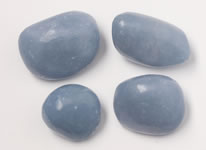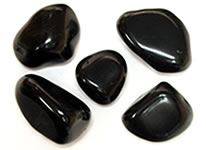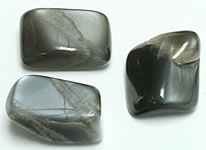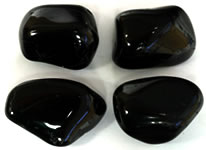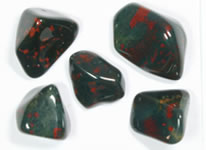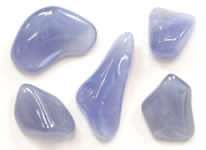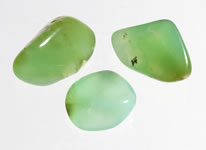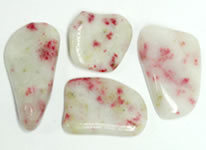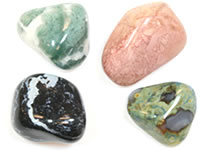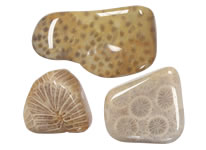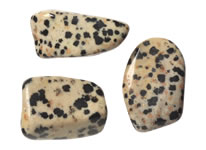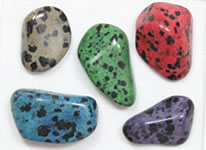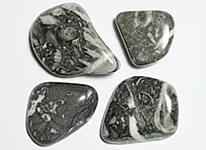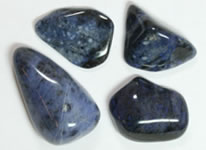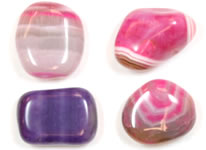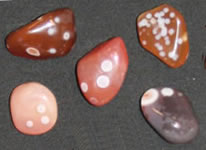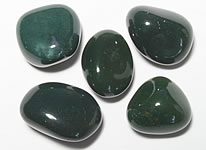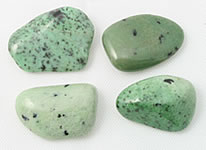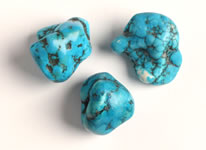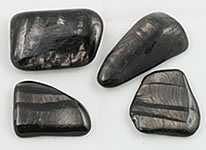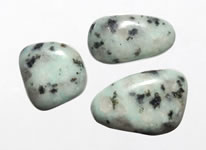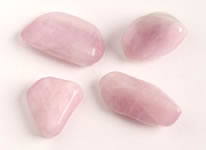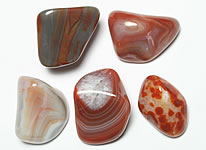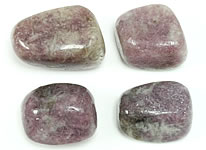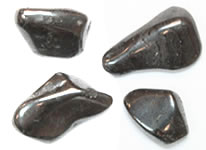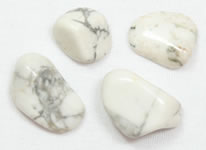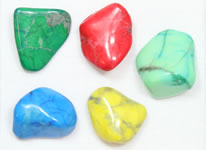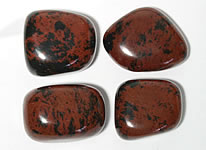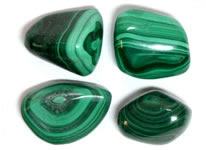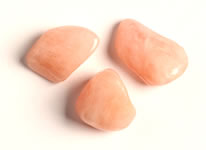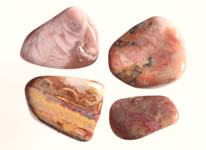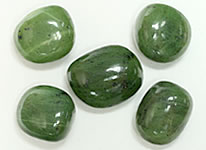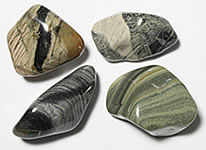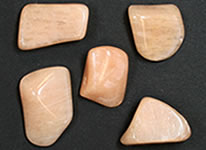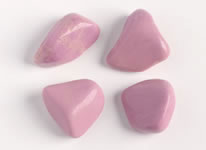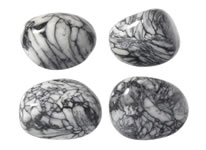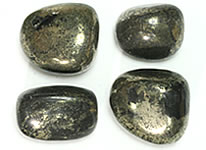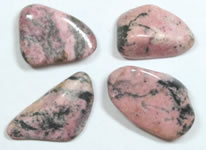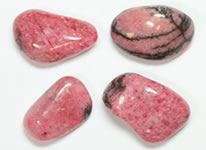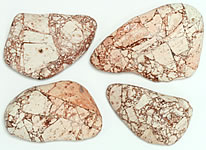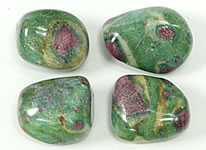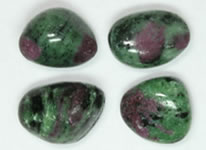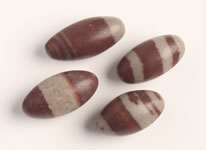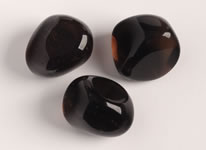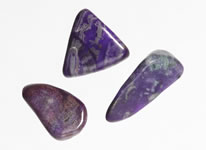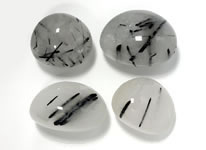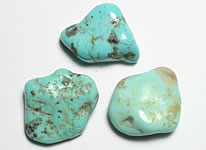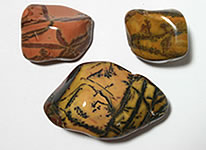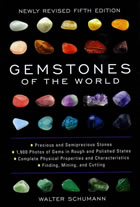Amazonite
Amazonite is a green microcline feldspar. It is named after the Amazon River of South America, where the first commercial deposits were found. The stones shown here are a light green Amazonite that was mined in Mozambique.
Shop for Amazonite.

Angelite
Angelite is a marketing name for blue anyhdrite - a calcium sulfate mineral related to gypsum. Angelite is very soft, with a hardness of 3 to 3.5 on the Mohs scale. It is unsuitable for use in jewelry because it will be easily abraded or broken. It has a very nice blue color, which is sometimes produced with dye.
Shop for Angelite.

Apache Tears
Apache Tears are rounded nodules of obsidian that polish to a beautiful jet-black color. If you hold them up to the light, you will see that they are a translucent to transparent glass. These polished Apache Tears were produced from a material found in Arizona (USA).
Shop for Apache Tears.

Apricot Agate
Apricot Agate is a banded agate that is named for its apricot pink or orange color. It is a beautiful material with bands of whites, creams, yellows, oranges and pinks. The stones shown here were produced from agate mined in Botswana (Africa).
Shop for Apricot Agate.

Aquamarine (Blue Beryl)
Beryl is a mineral that occurs in a variety of colors. Attractive pieces are used as a gem. Transparent blue beryl is the popular gemstone known as "aquamarine". When it is translucent to opaque, the name "blue beryl" is most appropriate, but some mall jewelry stores use the name aquamarine.
Shop for Aquamarine.

Banded Amethyst
Amethyst is the name given to transparent to translucent purple quartz. It often forms in alternating bands with white to clear quartz. The resulting material is called Banded Amethyst or sometimes Chevron Amethyst. The Banded Amethyst used to produce these stones was mined in Namibia (Africa).
Shop for Banded Amethyst.

Banded Carnelian
Carnelian is a translucent orange to red or brown agate. It often forms in alternating bands with white chalcedony. The result is known as Banded Carnelian. These stones were produced from an orange to pink material mined in Botswana (Africa).
Shop for Banded Carnelian.

Banded Red Jasper
This red jasper is striped with thin bands of black mineral material. The black bands on some stones are weakly magnetic, so the minerals contained within them are most likely magnetite or magnetic hematite. The stones shown here are associated with the Precambrian banded iron ores of South Africa.
Shop for Banded Red Jasper.

Black Chalcedony
Black Chalcedony is a variety of microcrystalline quartz with a black color. Most material sold as black chalcedony has been altered by dye or other treatment to produce the black color. When the material has black and white parallel bands, it is known as "onyx".

Black Moonstone
Moonstone occurs in a wide variety of colors, including black and dark gray. The black to gray bodycolor is visible from most directions, but when the angle of light or angle of observation is just right, a flash of silver adularescence is produced. The luster approaches metallic.

Black Obsidian
Obsidian is a natural volcanic glass that forms when molten rock material cools so quickly that mineral crystals do not have time to form within it. Obsidian can be found in several different colors, but black is the most common.
Shop for Black Obsidian.

Black Tourmaline
Tourmaline has one of the widest color ranges of any gem. The colors are caused by the mineral's many compositions. The most common tourmaline color is a material that is so black that it is essentially opaque. This pitch-black variety is known as "schorl."

Bloodstone
Bloodstone, also known as heliotrope, is a green jasper splashed with small drops of red. The red drops remind many people of blood, and that is the source of the name Bloodstone. It has been a popular stone since Biblical times. The Bloodstone shown here was produced from material mined in India.

Blue Chalcedony
There are very few blue gemstones. Occasionally the variety of microcrystalline quartz known as chalcedony occurs in a blue color, such as this blue material mined in Namibia (Africa).

Blue Lace Agate
Blue Lace Agate is the name given to a chalcedony that consists of alternating bands of white agate and subtle blue to transparent agate. The result is a lacy appearance that looks like blue lace. The Blue Lace Agate shown here was produced from material found in Namibia (Africa).
Shop for Blue Lace Agate.

Blue Quartzite
Blue quartzite is a metamorphosed sandstone that receives its color from tiny blue inclusions of a fibrous mineral that is probably dumortierite. The abundance of the inclusions causes color variation within the stone and some intense blue bands where the inclusions are most abundant.
Shop for Blue Quartzite.

Botswana Agate
Botswana Agate is a name given to a banded agate found in Botswana (Africa). This agate typically has wonderful white, gray and brown banding - sometimes with "eyes" - and takes a very high polish.
Shop for Botswana Agate.

Brazilian Agate
Any type of agate from the country of Brazil can be called "Brazilian agate". The stones shown here have attractive red, orange, yellow, brown, and white banding. They have a wonderful translucence and a super-shiny polish.
Shop for Brazilian Agate.

Brecciated Jasper
"Breccia" is a rock composed of angular fragments. Brecciated jasper consists of jasper fragments cemented together with agate or jasper. The Brecciated Jasper shown here is a bright red material with white, gray and black markings. These stones were produced from material found in South Africa.
Shop for Brecciated Jasper.

Calcite
Calcite is one of Earth's most abundant minerals, but it is rarely seen as a tumbled stone because it has perfect cleavage (which makes it break during tumbling) and because it is very soft and very difficult to polish. These pieces of tumbled calcite have a spectacular translucent color and a wonderful polish.
Shop for Yellow Calcite.

Carnelian Agate
Carnelian Agate is a translucent orange to red or brown agate. It has been a popular gemstone since Biblical times. The stones shown here have a bright orange color and a very bright polish. They were produced from agate found in Botswana (Africa).
Shop for Carnelian.

Catlinite / Pipestone
Catlinite is a brownish red variety of mudstone that has been slightly metamorphosed. It is soft and can be easily carved without metal tools. Native Americans have made ceremonial pipes from catlinite for hundreds of years - and for that reason, the material is also known as "pipestone".

Cat's-Eye Glass
Cat's-Eye Glass is a man-made material that is a byproduct of the fiber optics industry. It is a glass that is filled with parallel bundles of optical fibers. When a beam of light enters the glass and strikes these fibers, it reflects from them, creating a phenomenon known as a "cat's eye" or "chatoyance".
Shop for Cat's-Eye Glass.

Chrysocolla in Quartz
Chrysocolla is a vivid blue to blue-green mineral that contains copper. It often forms in intimate association with quartz or chalcedony to yield a durable gemstone. Chrysocolla is often found associated with copper deposits, much like the mineral turquoise. These stones were produced from material mined in Namibia (Africa).
Shop for Chrysocolla.

Chrysoprase
Chrysoprase is a yellowish green to green variety of chalcedony. Its green color is usually caused by trace amounts of nickel. It is the second-most-valuable variety of chalcedony after gem silica. Most chrysoprase is mined in Australia. It is not seen in mass-market jewelry because supplies are limited.

Cinnabrite
Cinnabrite is a rock composed of scapolite (white) and epidote (red). Its eye-catching appearance makes it an interesting gem material for making cabochons, tumbled stones and other items. Its name makes some people think that it is composed of cinnabar and quartz, but that is incorrect.

Citrine Quartz
Citrine is a variety of transparent to translucent quartz that ranges in color from a light yellow through orange to amber brown. Yellow and golden citrine is especially popular. These stones were produced from material found in Brazil. Most citrine quartz is produced by heat-treating Amethyst.
Shop for Citrine Quartz.

Citron Magnesite
Citron Magnesite is a pale green to bright green magnesium carbonate with a color similar to ripening citrus fruit. That's the source of the name "citron". These stones have a soft luster polish and were produced from material found in Australia.
Shop for Citron Magnesite.

Clear Quartz
Quartz is one of the most abundant minerals in Earth's crust, but clear specimens with very little color that are nearly free from inclusions are seldom found. They are known as "clear quartz" or "rock crystal". They capture the light and have a "bright" appearance. Shop for
Clear Quartz.

Colored Moonstone
Moonstone is the name used for stones of orthoclase feldspar with a soft pearly luster, sometimes with adularescence. It occurs in a variety of colors which include: white, cream, pink, brown and gray. These colored moonstones were produced from material found in India.
Shop for Colored Moonstone.

Confusionite
Confusionite is a material that, at least to the observer, is difficult or impossible to identify. No person who possesses an abundant number of polished stones should be ashamed to confess that he cannot identify a significant number. These stones can be called "confusionite" to reduce embarrassment.

Convoluted Jasper
Convoluted jasper is named for the many bands and layers that traverse the stone. This material is red with fine bands of white to cream to brown. Some pieces contain particles of hematite which give the stone a high specific gravity. The material shown here has a brilliant shiny polish.
Shop for Convoluted Jasper.

Coral, Agatized
A rare find is fossil coral that has been replaced by agate - or agatized. This type of fossilization often preserves the structure of the coral individual or colony. The result can be a beautiful stone that can be polished to display cross and lateral sections through the coral fossil.
Shop for Agatized Coral.

Crackle Quartz
"
Crackle Quartz" is a name used for quartz specimens that have been heat treated and then
dyed to change their color. The heating and subsequent cold-water quenching produces fractures in the stone that facilitate the penetration of dyes.

Crazy Lace Agate
Crazy Lace Agate is a white to gray botryoidal agate with colorful stains that are usually yellow, orange, red and brown. Most of the material offered for sale originates in Mexico. It exhibits a lace-like pattern of curves and eyes and is a popular material for tumbled stones, cabochons and beads.
Shop for Crazy Lace Agate.

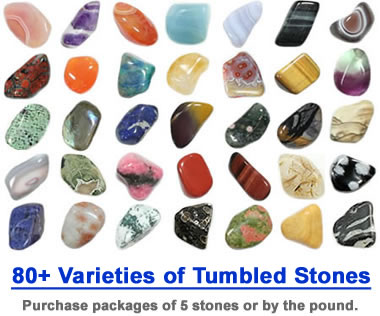

Dalmatian Stone
Dalmatian Stone was named because white specimens have a color pattern similar to a Dalmatian dog. Contrary to popular belief, this material is not a "jasper". We sent some to a lab for X-ray diffraction, and it is actually an igneous rock (learn more
here). The white is a mixture of albite and quartz, and the black spots are a mineral called arfvedsonite. We often have
Dalmatian Stone tumbling rough and
tumbled stones for sale.

Dalmatian Stone (Dyed)
Dalmatian Stone is a white to gray igneous rock with black spots. Dalmatian Stone readily accepts dye, and it is often dyed a variety of colors like four of the stones in the accompanying photo. Manufacturers can transform this inexpensive and easily worked material into colorful beads and tumbled stones with great sales appeal.

Dolomite
Dolomite is a sedimentary rock that is very similar to limestone. Most people would never think of it as a gemstone. However, it can be brightly polished by people who know how, and it often contains interesting fossils of brachiopods, crinoids, bryozoans and other ancient organisms.

Dragon Blood
Dragon Blood is a rock containing two members of the epidote mineral group. The green material is epidote and the red is piemontite. Some people call this material "Dragon Jasper" but that is incorrect - jasper is a cryptocrystalline quartz and an opaque variety of chalcedony.
Shop for Dragon Blood.

Dumortierite
Dumortierite is a bright blue, dark blue or greenish-blue mineral that is occasionally found in metamorphic rocks. It can be polished to a high luster and is one of just a few blue minerals that are hard enough to be used as a gemstone. The stones shown here were produced from material mined in Mozambique (Africa).
Shop for Dumortierite.

Dyed Agate
Agate is a variety of chalcedony that can be extremely colorful. It is slightly porous, with some bands and zones being more porous than others. When heat treated and exposed to
dye, the porous zones absorb more dye than the less porous, producing a stone that is banded with various color intensities.

Eye Agate
"Eye agates" are rare agates that have perfectly circular markings or "eyes". These are actually three-dimensional features that extend into the stone in the shape of a hemisphere. Sometimes
eye agate has concentric or "bull's eye" color zones. Lake Superior and Botswana agates frequently display eyes.

Fancy Jasper
Fancy jasper is a dark green jasper with patches and splashes of other colors, such as red, yellow, and white. The colors and patterns vary from one piece to the next, making each stone truly unique. The stones shown here were produced from material mined in India.
Shop for Fancy Jasper.

Fluorite
Fluorite occurs in a variety of colors such as purple, green, yellow, blue and clear, and the colors are often banded. Fluorite often has a wonderful
fluorescence. Although it is beautiful, it is not well suited for jewelry use because it has a hardness of four and has perfect cleavage in four directions.
Shop for Fluorite.

Garnet Crystals in Marble
This is a metamorphic rock that contains reddish brown garnet crystals in a grayish marble. In some stones, you can clearly see the geometric outline of the crystals. Other stones contain so many garnet crystals that they are intergrown with one another.
Shop for Garnet Crystals in Marble.

Gneiss
Gneiss is a metamorphic rock in the shale - slate - phyllite - schist - gneiss sequence. It usually contains an abundance of feldspar minerals and quartz. Many specimens of gneiss can be brightly polished in a rock tumbler if they do not contain very much mica.

Goldstone
Goldstone is a man-made glass that contains abundant crystals with a bright metallic luster. Flat faces of the crystals catch and reflect light to give the stone a glittering appearance. The glittering is triggered by moving the stone, moving the light, or changing the angle of observation.
Shop for Goldstone.

Granite
Granite is an igneous rock composed of quartz and feldspar with minor amounts of micas, amphiboles and other minerals. It can be pink, white or gray in color. Although the minerals in granite have various hardnesses, it can easily be tumbled into attractive stones. Here are a few
granites that we tumbled.

Green Aventurine
Aventurine is a translucent quartz with inclusions of platy minerals such as muscovite mica, hematite or goethite. The inclusions reflect light entering the stone to produce a glistening known as "aventurescence." These stones were produced from material from Zimbabwe (Africa).
Shop for Green Aventurine.

Green Jasper
The most common jasper color is red, and after that in abundance is green jasper. It is often a very, very dark green - so dark that at first glance you think that it is black. When green jasper is marked with red splotches, the rock is then known as "bloodstone".

Green Moss Agate
Moss agate is a translucent to transparent chalcedony that contains visible inclusions with a mossy or dendritic shape. The moss agate shown here has dark green inclusions. These stones were produced from material found in India.
Shop for Green Moss Agate.

Grossularite Garnet
The grossularite garnet used to make tumbled stones, beads and carvings is an opaque, massive garnet that often has an attractive green color. It is found in South Africa, where it has been incorrectly called "Transvaal Jade" (it has no mineralogical relationship with jade).

Hematite
Hematite is an iron oxide mineral with a bright red or silver color. It is has a specific gravity that is about double that of the typical gemstone - thus it feels very heavy. This hematite has a bright silver metallic luster. The hematite used to produce these stones was found in Brazil.
Shop for Hematite.

Howlite (Dyed Blue)
Howlite is an inexpensive white mineral, often marked with gray to black spider webbing. In the 1950s someone dyed some howlite a nice blue color, and WOW! they had a turquoise look-alike. Since then it has fooled millions of people in tourist shops throughout the Southwestern U.S. and beyond.

Hypersthene
Hypersthene is a black silicate mineral occasionally found in igneous rocks such as gabbro, basalt and andesite. It accepts a bright polish which sometimes reveals zones and bands of a phenomenon that seems transitional between chatoyance and play-of-color.

Jet
Jet is an organic rock similar to coal, but instead of breaking like coal it can be cut, carved or polished into interesting sculptures, beads or faceted stones. Jet is a very light-weight material and was popular in jewelry of the Victorian Era. It is rarely seen as a tumbled stone.
Shop for Jet.

Kambaba
Kambaba is a dark green orbicular rock that takes a nice polish and is found in Madagascar. The Kambaba shown here is a dark green material with green to black circular markings (orbs). Kambaba is also known as "crocodile stone" because the markings on it remind some people of crocodile eyes.
Shop for Kambaba.

Kiwi Stone
Kiwi Stone has dark black spots on a faint bluish green background. It is composed of quartzite, and the black spots are flakes of chlorite. It is called "Kiwi Stone" because it is reportedly from New Zealand. Some people call it "jasper" but that name is incorrect.
Shop for Kiwi Stone.

Kunzite
Kunzite is a trade name for pink to purple, gem-quality specimens of the mineral spodumene, an ore of lithium. Spodumene with a yellowish green to green color is known as hiddenite. Kunzite is difficult to polish because it is brittle and often breaks with a subconchoidal to hackly fracture.

Labradorite
Labradorite is a variety of plagioclase feldspar that often exhibits bright flashes of electric yellow, green or blue when played in the light. This phenomenon is unique to the mineral and has been named "labradorescence." It is one of our favorite tumbled stones.
Shop for Labradorite.

Lake Superior Agate
Lake Superior Agates are banded chalcedony nodules that formed in the gas vesicles of ancient Canadian lava flows. Glaciers then scoured them from their host rock and carried them south into the Great Lakes region of the United States. They are beautiful red, brown and often crystal-centered agates.

Lapis Lazuli
Lapis Lazuli is a gemstone that has been popular since Biblical times. It is one of just a few blue gemstones. It often contains white calcite veins and sparkles of gold pyrite. The stones shown here have a bright blue color and were produced from material mined in Chile.
Shop for Lapis Lazuli.

Leopard Skin
Leopard Skin looks like its name. It is a cream to tan to pink rhyolite with black, white, red, or tan markings in a color pattern that resembles the fur of a leopard. It is a popular gemstone that polishes well. These stones were produced from material mined in Mexico.
Shop for Leopard Skin.

Lepidolite
Lepidolite is a variety of mica that occurs in a spectrum of colors that range from pink to deep lavender. The stones shown here are tumbled quartz pebbles that have enough lepidolite inclusions to yield pink and lavender gemstones.

Lilac Amethyst
Amethyst is a purple variety of crystalline quartz that can be transparent through translucent. When it has a soft purple color, it is often called "lilac amethyst". The stones shown here were produced from material mined in South Africa.
Shop for Lilac Amethyst.

Lionskin
Lionskin is a rock that contains fragments of golden tiger's-eye and other material cemented in a clear quartz or milky agate matrix. It might be considered a "tiger's-eye breccia" because the tiger's-eye fragments are angular in shape. Many of the breccia fragments display the chatoyance that gives tiger's-eye its name.
Shop for Lionskin.

Llanite
Llanite is a rock found in Texas and a few other locations that contains tiny euhedral (well-formed) crystals of blue quartz in a groundmass of pink and brown feldspar. The blue crystals attract attention and make llanite an interesting lapidary material. Its rock name is rhyolite porphyry.

Lodestone
Lodestone has amazed people for thousands of years because it is a natural magnet. When suspended on a string, it will orient itself with Earth's magnetic field. It has a silver metallic luster and is a variety of the iron ore magnetite. These specimens were found in the United States.

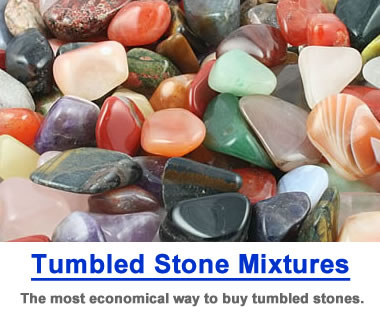

Magnesite
Magnesite is a magnesium carbonate mineral. It usually has a white or gray color and is sometimes marked with gray to black veins. It is porous, and its white color allows it to accept dye with very predictable color results. It is often confused with Howlite.
Shop for Magnesite.

Magnesite - Dyed
Magnesite is one of the most commonly dyed lapidary materials. It is often dyed to produce bright colors that are not often found in natural stones. It is also used as a
substitute for turquoise. These are sometimes sold without disclosure.

Mahogany Obsidian
Mahogany Obsidian is a rare variety of obsidian (a natural volcanic glass) that gets its name from its brown color. It ranges from a "black obsidian with brown markings" to a solid brown material. It accepts a very bright polish and is very popular because of that polish.
Shop for Mahogany Obsidian.

Malachite
Malachite is a green copper carbonate mineral. It often displays swirled and banded patterns in shades of light through dark green. It is a very heavy material because of its high copper content. These stones were produced from malachite mined in the Democratic Republic of the Congo (Africa).

Montana Moss Agate
Montana Moss is a transparent to translucent agate with brown and black mossy inclusions. The base color ranges from clear through milky to amber brown. It is named after the State of Montana, where it is found at many locations and is a popular rough with lapidaries.

Mookaite
Mookaite is silicified radiolarian siltstone that is found in Western Australia. Many specimens of Mookaite can accept a very high polish. It is widely known for its spectacular contrasting color patterns of yellows, creams, reds and maroons.
Shop for Mookaite.

Morganite
Morganite is a variety of the mineral beryl, defined by its delicate orange to pink color. Translucent pieces are made into beads and tumbled stones. Transparent pieces are faceted. Since about 2010, morganite has become a very popular jewelry stone that is often set in rose-color gold.

Mozarkite
Mozarkite is a colorful chert found at many locations in Missouri. It can be cut and polished and used as a gem. It was adopted as the official state rock of Missouri by the State General Assembly in 1967. As the official state rock, it is a popular item in tourist and gift shops. It makes beautiful tumbled stones.

Nephrite
Nephrite and jadeite are the two minerals that can rightfully be called "jade." Nephrite is the less valuable of the pair. It occurs in colors that range through white, cream, green, gray and black. It can be difficult to polish in a rock tumbler because it is so tough.

Ocean Jasper
Ocean Jasper, sometimes called "orbicular jasper," is a silicified rhyolite or tuff that contains "eyes" formed from radial quartz and feldspar crystals. It occurs in a variety of colors, but green, yellow, white, pink and cream color patterns are very common. It often has an amazing
fluorescence.
Shop for Ocean Jasper.

Oil Shale
Most people think of a sticky, gooey rock when they hear the name "oil shale". However, it is often silicified enough that it can be polished in a rock tumbler to produce beautiful banded tumbled stones with subtle shades of gray, brown, tan and green.

Olive Opal
Olive opal is a color variety of common opal with a greenish yellow or yellowish green to black color. It can be translucent to opaque, and translucent pieces often have a resinous appearance that reminds you of a greenish amber.
Shop for Olive Opal.

Orange Quartz
Quartz naturally occurs in almost every color of the spectrum. These colors are caused by impurities in the quartz crystal. This gemmy orange quartz in a beautiful peachy color was produced from a mine in India.
Shop for Orange Quartz.

Orange Quartzite
Quartzite is a durable metamorphic rock that can be found in a wide variety of colors. The material shown here has a delicate peachy orange color and a superb polish.
Shop for Orange Quartzite.

Orthoclase
Orthoclase is a very common mineral of the feldspar family. It often has a pleasing peach color and soft pearly luster. Surprisingly, orthoclase has not received the same level of lapidary attention as amazonite - another feldspar mineral with an interesting color. It has right-angle cleavage and often breaks into interesting shapes.

Petrified Wood
Petrified wood forms when plant debris is buried and then replaced by mineral material such as chalcedony or opal. This often occurs when a forest is buried under a volcanic ash fall. When polished, these pieces of wood often display interesting grain patterns that can sometimes be linked to a specific type of plant.
Shop for Petrified Wood.

Petrified Wood (Arizona)
Petrified wood is found at many localities worldwide. The most famous are in the state of Arizona (USA). Much of the petrified wood found there is various shades of red without distinctive wood grain. It is sometimes found as logs or tree segments. Most is found as small pieces scattered on the surface or in dry washes.
Shop for Arizona Petrified Wood.

Phosphosiderite
Phosphosiderite is an iron phosphate mineral that is popular in tumbled stones because it occurs in a range of translucent to opaque purples, pinks, and violets that are rarely seen in other gem materials. It is a fragile material with a hardness of only 3 1/2 to 4.

Picasso Stone
"Picasso stone" reminds many people of the interesting art style of the famous painter, Pablo Picasso. It is a beautiful material with angular patterns in gray, brown, black, cream, white and other colors. These stones were produced from material found in Utah (USA).
Shop for Picasso Stone.

Picture Jasper
Picture Jasper is a material marked with colors and patterns that look like "landscape" scenes - thus the name "picture jasper." If you study a stone, you will often find interesting "pictures" of landscapes and deserts. These stones were produced from material found in Namibia (Africa).
Shop for Picture Jasper.

Pink Aventurine
Aventurine is a quartz with abundant inclusions of platy minerals such as mica. The inclusions reflect and scatter light within the stone to produce a glittering phenomenon known as "aventurescence." The pink stones shown here were produced from material mined in Canada.
Shop for Pink Aventurine.

Pink Botswana Agate
"Botswana agate" is the name given to banded agates produced in the country of Botswana (Africa). Some of these stones occur in a gray through creamy pink color. These are known as "Pink Botswana."
Shop for Pink Botswana Agate.

Pink Opal
Pink opal is a variety of common opal that is rarely seen as a
tumbled stone. It can be a beautiful material even though it lacks the "play-of-color" exhibited by precious opal. These specimens were mined in Peru, a country that is well known for producing pink opal.

Pinolith (or Pinolite)
Pinolith is a black and white, or gray and white, metamorphic rock in which white pine-nut-shaped crystals of magnesite stand out in contrast to a matrix of gray dolomite or black graphitic dolomite. At present, the single source is in Austria and northeastern Spain.

Polychrome Jasper
Polychrome Jasper gets its name from its many colors - "poly" + "chrome". It is often red, brown, orange, gray, white, and bluish or greenish colors. These colors are usually arranged in banded or swirled patterns. The most famous deposit is in Madagascar, but look-alike material is found in many areas.

Prasiolite
Prasiolite is a green quartz produced when amethyst is naturally heated, or, when amethyst is heated or irradiated by people. Color produced by people should be disclosed if the material is being sold. It is often called "green amethyst" but that name is a misnomer, considered to be deceptive or misleading.
Shop for Prasiolite.

Prehnite
Prehnite is a yellow to green silicate mineral that is occasionally found in igneous and metamorphic rocks. The specimens used as gemstones generally are transparent to translucent with a pleasing yellow-green color. The stones shown here were produced from material mined in South Africa.
Shop for Prehnite.

Puddingstone
"Puddingstone" is a colloquial name for this calcite conglomerate rock. Its appearance reminds some people of a plum pudding. In these specimens, a cream to orangy beige matrix contains a multitude of rounded to subrounded pebbles.
Shop for Puddingstone.

Pyrite
Pyrite is one of Earth's most common minerals. It is found almost everywhere and in almost every type of rock. Its metallic yellow color causes it to be often mistaken for the much more valuable gold. That's how it earned the name "fool's gold." Some people call this material "healer's gold" - but it has no medicinal value.

Rainbow "Hematite"
Rainbow "Hematite" is a man-made material that is often given a thin coating of an iridescent metallic material. The bright iridescent colors really attract attention and produce sales in gift, souvenir, and science stores. The name "hematite" is in quotes because it is a misnomer.

Rainforest Rhyolite
Rainforest Rhyolite is a mottled greenish to brown, heavily patterned material that is thought to have formed from the silicification of rhyolite. It can contain numerous orbs, poppy-shaped structures, and occasional vugs that are sometimes filled with a milky to bluish chalcedony. Some people call it "Rainforest Jasper".
Shop for Rainforest Rhyolite.

Red Jasper
Jasper is an opaque chalcedony, and red is one of its most common colors. This red jasper from South Africa has a fire-engine red color that in some stones is interrupted by a white to transparent quartz vein. It often accepts an exceptionally high polish.
Shop for Red Jasper.

Rhodochrosite
Rhodochrosite is a pink mineral that often has a banded appearance. It forms in subsurface fractures, cavities, and caverns. It is a soft mineral with perfect cleavage, and that limits its jewelry use to pieces that will not be subjected to impact or abrasion.

Rhodonite - Pink
Rhodonite is a metamorphic manganese mineral that is well known for its beautiful pink color. It is often found as nodules that are cut by abundant black veins of other manganese minerals. The material used to produce these stones was mined in Canada.

Rhodonite - Raspberry
Raspberry rhodonite is a bright pink variety of the manganese mineral, rhodonite. It is a metamorphic mineral with a gemmy pink color that is often interrupted by veins of black manganese oxide. The specimens shown here were found in Madagascar.

Rhyolite
Rhyolite is an extrusive igneous rock that is produced during gas-charged explosive eruptions. When rhyolite has been silicified, it can be polished in a rock tumbler. The material shown here is known as "chipboard" because its broken appearance reminds some people of the inexpensive substitute for plywood.

Rose Quartz
Rose quartz is a transparent to translucent variety of crystalline quartz with a soft pink color. It takes a very high polish and is an exceptionally popular semiprecious stone. The material used to produce these stones was mined in Namibia (Africa).
Shop for Rose Quartz.

Ruby in Feldspar
Ruby in Feldspar is a trade name for a metamorphic rock in which crystals of pink and red corundum (the "ruby") are surrounded by a fine-grained matrix that contains abundant tiny feldspar grains. A nice big ruby in one of these stones immediately attracts attention.

Ruby in Fuchsite
Fuchsite is a green mineral of the mica family, and ruby is a well-known gem material. When together they are called Ruby in Fuchsite. It is often confused with Ruby in Zoisite. They are easy to tell apart because R-i-F usually contains some blue kyanite near the "rubies."

Ruby in Zoisite
Zoisite is a mineral that is rarely found in metamorphic rocks. Even more rarely, it contains bright red corundum crystals (rubies). This bright green zoisite mined in Tanzania (Africa) contains occasional red rubies a few millimeters in diameter.



Rutilated Quartz
Rutilated quartz is clear to smoky quartz that contains needle-like inclusions of rutile. The number of rutile needles can range from a few thin isolated needles to a dense network of intersecting fibers. The needles are often golden in color and align with the crystallographic axes of the quartz.
Shop for Rutilated Quartz.

Septarian Stone
These stones are pieces of broken septarian nodules that have been tumbled and polished. The stones consist of a gray matrix, a brown shrinkage crack linking, and the crystalline yellow calcite which filled the shrinkage cracks within the nodules.
Shop for Septarian Stone.

Serpentine
Serpentine is the name used for a large group of minerals that are often cut and polished into beautiful gemstones, ornamental stones and architectural materials. It is sometimes used for fine carvings. It can be difficult to tumble to a bright polish, but a few people have mastered that work.
Shop for Serpentine.

Serpentine (Peruvian)
This is an unusual type of serpentine that sometimes contains a variety of metallic mineral inclusions. These can include pyrite, magnetite, and chromite. The color of the serpentine ranges from a pale yellowish green to a deep olive green.
Shop for Peruvian Serpentine.

Serpentine (Yellow)
This serpentine is a bright greenish yellow color. Some pieces have a uniform color, while others are mottled, banded, or cross-cut with fracture fillings. This material has a soft waxy luster.
Shop for Yellow Serpentine.

Shiva Lingam
Shiva Lingam stones are made from stream pebbles and cobbles found in sediments of India's Narmada River. People collect them, improve their shape, and polish them. This work is usually done by hand. They are often used as a "healing stone" and are an item of much Indian folklore.

Smoky Quartz
Smoky Quartz is a light yellowish brown to orangy brown to reddish brown to dark brown variety of crystalline quartz. The specimens in the photo have such a dark brown color that they appear to be almost opaque. Smoky quartz is most often seen as a faceted stone in fashion jewelry.

Snakeskin
"Snakeskin" was given its name because its green and black pattern is reminiscent of the scales on a snake. Some people are calling this material "snakeskin jasper", but the name "jasper" is not accurate in this context. Genuine jasper has a hardness of 7 on the Mohs scale, while snakeskin has a hardness of only 4.
Shop for Snakeskin.

Snowflake Obsidian
Obsidian is a natural volcanic glass that can be polished to a very high luster. Some stones of obsidian contain white crystals of the mineral cristobalite. When polished, these stones produce a gemstone known as snowflake obsidian.
Shop for Snowflake Obsidian.

Sodalite
Blue rocks and minerals are rare, and that is what makes sodalite an interesting mineral. It is an igneous mineral named for its sodium content. It typically occurs in a range of blue hues, but white and pink colors are also common.
Shop for Sodalite.

Sugilite
Sugilite is a rare silicate mineral that is best known for its translucent pink to purple to magenta color. More commonly, sugilite is mottled and crossed by veins of various gray, white, and black materials. It is often mispronounced. Proper pronunciation is "
sue-gee-lite".

Sunset Sodalite
"Sunset Sodalite" is a name used for blue sodalite that contains patches of pinkish orange. Blue rocks and minerals are uncommon to begin with, and it is even more unusual to find a blue mineral that is mixed with a contrasting color such as orange. This material, also called "sunrise sodalite", was named because its colors are reminiscent of the sky at dusk or dawn.
Shop for Sunset Sodalite.

Sunstone
Sunstone is a plagioclase feldspar that contains abundant inclusions of platy minerals such as mica or metals that sparkle in reflected light. This sparkling luster is known as aventurescence. These specimens of sunstone were mined in India.
Shop for Sunstone.

Tiger Iron
Tiger Iron is a stone that is a mixture of several materials. These can include tiger's-eye, jasper, and iron ore minerals such as hematite or magnetite. The different materials occur in layers and patches, giving the stones an interesting appearance.
Shop for Tiger Iron.

Tiger's-Eye - Blue
Tiger's-Eye receives its name from how reflected light forms a band that crosses the stone at a right angle to linear structures within the stone. Although the most popular Tiger's-Eye is golden to brown in color, it also occurs in other colors such as this deep blue material found in South Africa.
Shop for Blue Tiger's-Eye.

Tiger's-Eye - Gold
Tiger's-Eye receives its name from reflections of light that form a band crossing the stone at a right angle to fibrous structures within the stone. The Tiger's-Eye shown here is the popular and typical golden brown color. These stones were produced from material found in South Africa.
Shop for Gold Tiger's-Eye.

Tiger's-Eye - Multi
This unusual stone is a combination of blue and gold tiger's-eye. As you can see from the photo, the colors can occur in blocky patches, or they can be finely intermixed within the same stone.
Shop for Multi Tiger's-Eye.

Tiger's-Eye - Red
Most Tiger's-Eye is a honey to golden brown color; however, it is sometimes heat-treated to produce a deep reddish color. A small amount of red tiger's-eye is produced by natural heating. These stones were produced from material found in South Africa.
Shop for Red Tiger's-Eye.

Tourmalinated Quartz
Tourmalinated Quartz is the name used for specimens of rock crystal quartz that contain visible inclusions of tourmaline. In these stones, the tourmaline occurs as prismatic crystals of schorl, the black tourmaline. Other varieties of tourmaline can be present in quartz, but schorl is by far the most common.

Tree Agate
Tree agate is a name used for a white chalcedony that has green dendritic markings. It is a very popular material used to make beads, cabochons and tumbled gemstones. The stones shown here were produced from material mined in Botswana.
Shop for Tree Agate.

Turquoise
Turquoise is a gemstone that is so famous for its distinctive blue-green color that the name of the gemstone has entered common language. Turquoise has been mined in many parts of the world. Its most famous use is in the Native American art produced by the people of the southwestern United States.

Turritella
Turritella is a rockhound name used for a brown, translucent, fossiliferous agate found in the Green River Formation of Wyoming. The name was given because the christener thought the fossils were of the
Turritella genus (they are really
Elimia tenera), but the name has stuck.
Shop for Turritella Agate.

Unakite
Unakite is an igneous rock that contains mostly green epidote and pink orthoclase, but with minor amounts of quartz and other minerals. It is often polished to produce an interesting gemstone. The stones shown here were produced from material mined in South Africa.
Shop for Unakite.

White Moonstone
Moonstone is the name used for stones of orthoclase feldspar with a soft pearly luster, sometimes with adularescence or
fluorescence. These white to cream-color stones have a nice pearly luster and bright polish. They were produced from moonstone mined in India.
Shop for White Moonstone.

White Quartz
White quartz is one of Earth's small number of ubiquitous minerals - that means it is found almost everywhere. Perhaps it is rarely polished because it is so common that it is overlooked. However, it is a beautiful tumbled stone that works nicely in jewelry and craft projects.
Shop for White Quartz.

Yellow Feather Jasper
Yellow feather is a multi-color jasper found in Utah. The name "yellow feather" was inspired by dark feather-like markings that cut across a basecolor of yellow, brown or reddish orange. It is used to make interesting tumbled stones.

Yellow Jasper
Yellow Jasper is an opaque yellow to yellow-brown-beige chalcedony that can be polished to a very high luster. These stones, produced from material mined in South Africa, show some dark brown to cream color zones that produce a scenic pattern.
Shop for Yellow Jasper.

Yellow Quartz
Yellow Quartz is a translucent to transparent quartz with a light to deep yellow color. These translucent stones were produced from material mined in India and have a very bright polish.
Shop for Yellow Quartz.

Zebra Marble
Zebra Marble is a black and white material that has a coloration similar to a zebra. It is a dolomitic marble in which the banded appearance is actually foliation caused by the heat and pressure of metamorphism.
Shop for Zebra Marble.

Zebradorite
Zebradorite is an igneous rock that forms when magma slowly cools deep below Earth's surface. The material shown here has quartz crystals within a matrix of off-white to pink feldspar. Other names for zebradorite include "graphic granite", "Hebrew stone", and "runite".
Shop for Zebradorite.

Gemstones of the World
Gemstones of the World (fifth edition) by Walter Schumann is one of the most popular gemstone books ever written. Over one million copies have been sold. It has about 100 pages of basic gemstone information and about 200 pages dedicated to photos and descriptions of over 100 gems and gem materials. It contains about 1900 photos of gemstones in rough and cut states. It is an easy-to-understand book written for people high school age and up. Get your copy of
Gemstones of the World.




